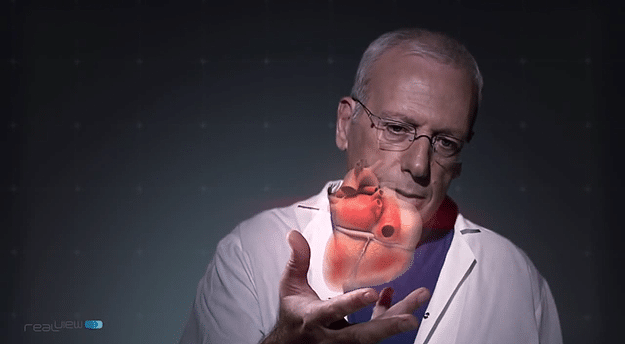Hologram or Holography is a technique that allows the light scattered from an object to be recorded and later reconstructed. The image changes as the position and orientation of the viewing system changes, thus making the recorded image (hologram) appear three dimensional. While this technique is able to create 3D holographic picture of a static object since the 1960s, Research and Development at Intel, IBM, ARM and Nokia promises that in five years, it will be available on Mobile Phones to produce holograms of friends and colleagues talking and moving in real time.
Holus is a table top interactive LIVE Hologram device that provides a blend between the digital and real world by converting any digital content into a 3D holographic experience.
Holus offers a number of new and exciting possibilities. Here are just a few of the ways it can be used:
Education
Holus provides a natural and intuitive way of perceiving information, making it an ideal entertainment system for homes or classrooms. Teachers can keep students engrossed in learning about DNA structure or the solar system by presenting information from multiple angles and encouraging physical interaction. Families can finally use technology to connect with each other by having digital board game nights and promoting a “social campfire” experience.
Games
In addition, Holus allows for a brand new gaming experience with content that comes alive and allows users to interact in ways not possible with other gaming systems. Moreover, it is a multi-user technology where any given content can be seen from four different viewing angles. The purpose of designing the Holus system is to bridge the gap between humans and digital information.
Development
Holus Pro is the developer’s edition and comes equipped with an HDMI port and SDK, so users can create whatever they can imagine in a holographic experience. Ultimately, the device can be programmed to provide everything from holographic teleconferencing to realistic previews of 3D printing products and Star Trek-like holodecks. Both Unity and Unreal, two of the most powerful video game engines, will be supported by the SDK. Leap and Emotiv will also be partnering with H+ to assist developers in bringing even more capabilities of Holus to life.

One of the most exciting developments in the Holography world is the progress of Holographic TV, initiated by the work of Stephen Benton at MIT, which is the place where Real-time, moving holograms are currently being researched, which will eventually result in holographic TV as a consumer device within coming few years.
Soon enough, you may actually get a message in the form of a 3D hologram, with Korean researchers boasting the creation of the first 360-degree color hologram, in the form of a floating Rubik’s cube.
The research was led by a 16-company consortium called ETRI, with LG at the helm, and according to the consortium the creation is a “tabletop holographic display” that a person can view from all different angles. Basically, it’s a true hologram, not a hologram that looks 3D through visual effects but is really 2D.
The research is the culmination of a project started by the Korean government back in 2013, which started with the goal of developing hologram technology. The team behind the tech created the hologram using powerful lasers that are able to use diffraction to create 3D objects, producing color interference between differently-hued lasers.

Of course, there are some limitations to the new technology. For one, the hologram is only around 3-inches in size, and the technology behind it is very complex, meaning that we probably won’t see anything using the new tech in our homes for at least a few years. By 2021, however, ETRI hopes to commercialize a 10-inch “Holo TV.”
But 3D Holograms and related Holographic Display Technology has much more applications than just movies and live performances, ranging from Defense, Scientific Research, Business, Education and Living Room Entertainment to almost every area of life that involves display screens.
Since Holograms can be displayed horizontally and can be viewed in 3 dimensions from 360 degree angels, they lend themselves remarkably useful for applications which require spatial precision to analyses, such as Geo-seismic Models, Terrain modelling, Scientific Visualization, Medical Dissections and Architectural Models.
for more details visit : http://musion.com/
